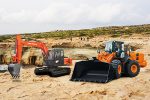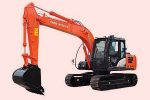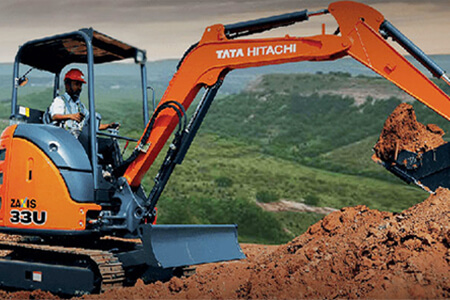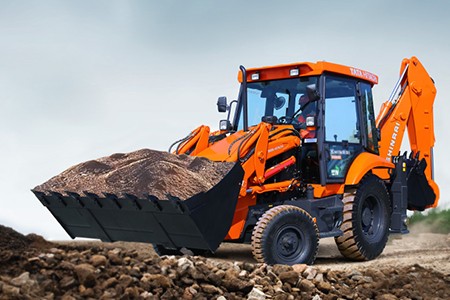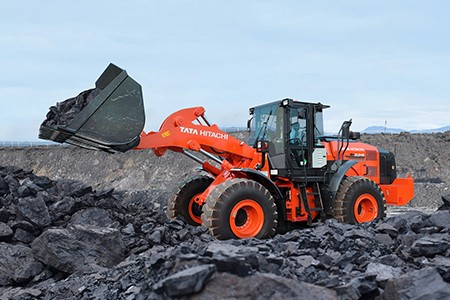Backhoe Loader: Versatile Equipment for Efficient Operations and Safety
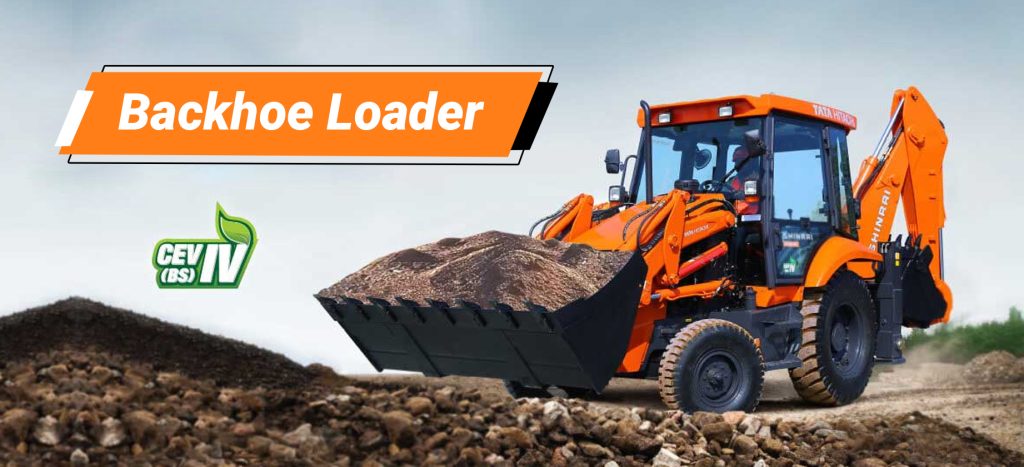 Backhoe loaders are powerful and versatile machines that have become a staple in the construction and excavation industries. Combining the capabilities of a wheel loader and an excavator, backhoe loaders offer a wide range of operations, making them invaluable on job sites. In this blog, we will explore the operations of a backhoe machine and provide essential safety tips to ensure the well-being of operators and those working around them.
Backhoe loaders are powerful and versatile machines that have become a staple in the construction and excavation industries. Combining the capabilities of a wheel loader and an excavator, backhoe loaders offer a wide range of operations, making them invaluable on job sites. In this blog, we will explore the operations of a backhoe machine and provide essential safety tips to ensure the well-being of operators and those working around them.
Operations of a Backhoe Loader:
With its loader bucket for loading and carrying materials, backhoe arm for excavation, stabilizers for stability, and compatibility with auxiliary attachments, the backhoe loader is a valuable asset in construction, excavation, and other industries requiring versatile and efficient equipment. The backhoe loader operations are mentioned below:-
Loader Operations:
The loader aspect of a backhoe loader machine is used for various tasks related to loading and carrying materials. It consists of a front-end loader bucket that can be raised, lowered, and tilted by the operator. This allows for efficient loading and unloading of materials such as soil, gravel, or debris onto trucks or into designated areas.
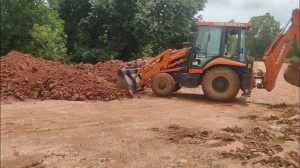
-
Backhoe Operations:
The backhoe function of a backhoe machine is used for excavation purposes. It includes a hydraulic-powered digging arm attached to the rear of the machine. The backhoe arm’s reach, angle, and digging depth are all within the operator’s control. This enables the backhoe machines to perform tasks like digging trenches, foundations, ditches, and other excavations.
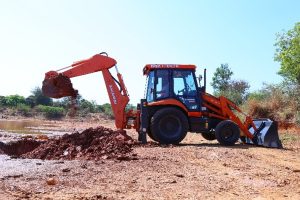
Stabilizer Operations:
Backhoe machines have stabilizers to ensure stability and safety during heavy-duty operations. Extensible legs, known as stabilizers, are deployed on either side of the machine’s back. They provide a solid base and prevent the backhoe loader machine from tipping over. The stabilizers enhance the machine’s stability, allowing for more efficient and secure operations.-
Versatile Attachments:
Backhoe loaders are versatile machines that can accommodate various auxiliary attachments to enhance their capabilities. These attachments include Rock Breaker, Orange Peel Grab, Clamshell, Magnet, Slurry Pump, Drum Cutter, Crusher, Hedge Trimmer, and Mulcher. Using different attachments makes the backhoe loader machine adaptable to different tasks and environments, expanding its functionality and versatility.
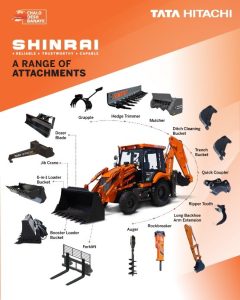
-
Mobility Operations:
One of the key capabilities of a backhoe loader is its mobility function, which enables it to navigate various terrains and work in different environments easily. The backhoe loader has a four-wheel drive, allowing it to traverse rough, uneven surfaces, including muddy or sandy terrain. Its articulated steering gives it excellent maneuverability, making it suitable for working in urban areas. The backhoe loader can also be driven on roads, enabling efficient transportation between job sites. This mobility function enhances the backhoe loader’s productivity and efficiency, as it can quickly and easily reposition itself to perform various tasks, such as excavating, loading, and material handling, in different locations. Overall, the mobility operations of a backhoe loader are a crucial aspect of its functionality, enabling it to be a versatile and reliable machine in construction, landscaping, and other industries.
Backhoe Loader Safety Tips for Operating the Machine:
Operating a backhoe loader machine requires skill, knowledge, and a strong commitment to safety. Adhering to safety protocols is crucial to prevent accidents and maintain a safe working environment. Operating a backhoe machine safely is paramount to protecting operators and those working around the machine. Providing thorough training, conducting pre-operational inspections, following safe practices during operation, and maintaining regular equipment maintenance can significantly reduce the risks associated with backhoe loader operations. Always prioritize safety and follow industry best practices to maintain a safe working environment. Here are some detailed backhoe loader safety tips to consider when operating a backhoe loader:- Operator Training: Ensure operators receive comprehensive training on the safe operation of a backhoe loader. Training should cover the machine’s controls, functions, and safety features. Operators should understand the proper procedures for starting, operating, and shutting down the equipment.
- Pre-Operational Inspections: Perform thorough inspections before each use to ensure the backhoe loader is in proper working condition. Check for any visible damage, leaks, or loose components. Inspect tires, hydraulic systems, brakes, lights, and all safety devices. Report any defects or malfunctions immediately and avoid operating the machine until repairs have been made.
- Seat Belt Usage: Always wear a seat belt while operating a backhoe loader. Seat belts significantly reduce the risk of accidents to the operator in the event of a sudden stop, collision, or machine instability. Ensure that the seat belt is in good condition and properly fastened.
- Stability and Load Capacity: Know the backhoe loader’s load capacity and operating limitations. Stay within the manufacturer’s specified load capacity, which can compromise stability and lead to tipping or rollover accidents. Keep the load balanced and centered within the machine’s recommended limits.
- Proper Use of Stabilizers: Deploy the stabilizers before digging any operations. Stabilizers provide additional support and stability to the backhoe loader, especially when working on uneven or sloped terrain. Ensure the stabilisers are fully extended and firmly in contact with the ground before starting any operations.
- Safe Digging Practices: Exercise caution when digging with the backhoe arm. Before digging, identify the location of underground utilities and pipelines to avoid accidental damage. If necessary, contact utility companies to mark the areas. Use hand tools or smaller excavating equipment to expose utilities when necessary.
- Maintain Proper Visibility: Ensure good visibility from the operator’s seat. Keep windows, mirrors, and cameras clean and unobstructed. Adjust mirrors to provide a clear view of the surrounding work area. Use appropriate lighting during low-light conditions to improve visibility.
- Traffic and Work Zone Safety: Maintain a safe distance from other vehicles, pedestrians, and work areas. Observe and follow all traffic regulations when operating the backhoe loader on public roads or construction sites. Establish clear work zones with proper signage, barricades, and warning indicators to prevent unauthorized access.
- Regular Equipment Maintenance: Follow the manufacturer’s recommended maintenance schedule for the backhoe loader. Regularly inspect and service the machine to ensure all components, including brakes, hydraulics, and electrical systems, function properly. Document all maintenance and repairs for future reference.
- Insurance Coverage for Backhoe Loaders: Insurance is crucial for backhoe loaders to be protected from any risks and liabilities that may develop during operation. This insurance protects against mishaps, equipment damage, injuries to third parties or damage to their property, and other unanticipated occurrences. Equipment owners and operators are advised to speak with insurance companies specialising in covering construction equipment to ensure they have the necessary coverage.
Recent Articles
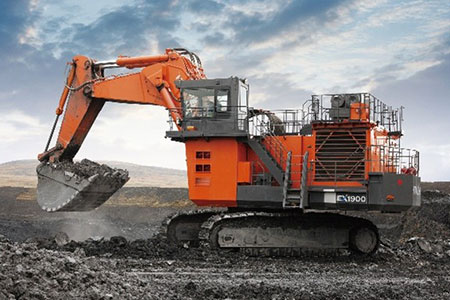
September 10, 2024.
A Comprehensive Guide to Mining Excavators by Tata Hitachi
A Comprehensive Guide to Mining Excavators by Tata Hitachi Having reliable and efficient equipment is essential for maximising productivity andContinue Reading
Read more →
March 28, 2024.
Unearthing the Power of Excavators: A Comprehensive Guide to Types and Applications
Excavator: Types, Specifications, Uses in Construction Site Excavators have revolutionized the construction and mining industries, providing unparalleled efficiency in earthmoving,Continue Reading
Read more →
March 28, 2024.
Enhancing Excavator Efficiency: A Comprehensive Guide to Excavator Attachments
Different Types of Excavator Attachments and Their Uses Excavators are strong equipment used extensively in building, mining, and other sectorsContinue Reading
Read more →
